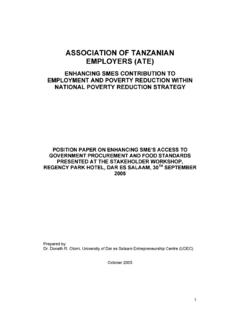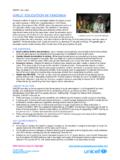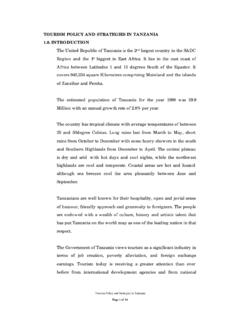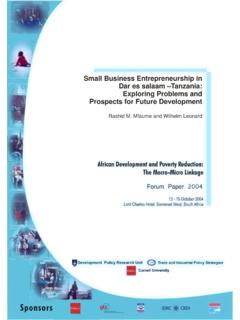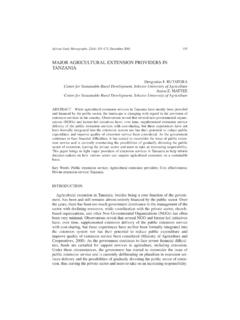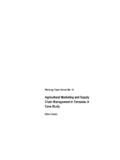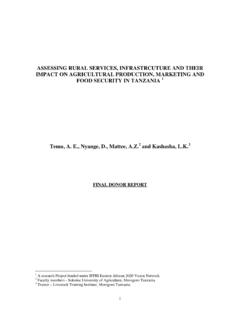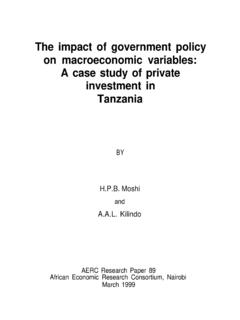Transcription of Tanzania-The status of Tanzanian honey Trade- Domestic …
1 Tanzania-The status of Tanzanian honey trade - Domestic and International Markets Mwakatobe, A. and Mlingwa, C. tanzania Wildlife Research Institute, Box 661, Arusha, tanzania .Tel: +255 0 (27) 2509871/2544677. Fax: +255 0 (27) 2548240. E-mail: Background Information Beekeeping in tanzania plays a major role in socio-economic development and environmental conservation. It is a source of food ( honey , pollen and brood), raw materials for various industries ( beeswax candles, lubricants), medicine ( honey , propolis, beeswax bee venom). and source of income for beekeepers. It is estimated that the sector generates about US$ million each year from sales of honey and beeswax and employ about 2 million rural people. It is an important income generating activity with high potential for improving incomes, especially for communities leaving close to forests and woodlands.
2 Beekeeping also plays a major role in improving biodiversity and increasing crop production through pollination. Beekeeping in tanzania is carried out using traditional methods that account for 99% of the total production of honey and beeswax in the country. Approximately 95% of all hives are traditional including log and bark hives. Others are reeds, gourds, pots etc. During the colonial and early independence period the production of bee products was higher than what we have now and was among the important non-wood products from the forests with a higher contribution to the national GDP and international trade (Kihwele, 1991). However, today the industry has declined in exports to an insignificant level despite of its high potential. tanzania ( then Tanganyika) was an important source of beeswax during the Germany colonial period (Ntenga, 1976).
3 The production of beeswax from tanzania increased from 320. to 905 tons during 1906 to 1952. honey was estimated at an annual average production of 10,000 tons, all consumed locally (Smith, 1958). Following independence in 1961, a marketing organization of honey and beeswax was formed. According to Ntenga (1976), Tanzanian exports averaged 368 tons of beeswax and 467 tons of honey . During the 1996/97 period, the 1. annual exports dropped to 359 tons of beeswax and tons of honey ( tanzania Customs Department, 1997). According to Seegeren . (1996), in 1984 world honey export totalled 270 000 tones of which 60% came from the tropics. Prices varied between US $ and kg-1. Beeswax, which, among other things, is used in the manufacture of cosmetics, candles, foundation sheets for hives, medicines and polishes, had a good and very stable market .
4 In 1990 world market prices varied between US$ 2 and 3 kg-1. Beeswax production varies from to kilograms hive-1 year-1 when frames are used and to 2 kilograms hive-1 year-1 when the honey is pressed and all combs are melted. In tanzania traditional beekeeping is credited for almost all production of honey and beeswax (Mwakatobe, 2001). Besides playing wider Domestic roles in the bees and bee-products industry in tanzania , beekeeping is also a good source of foreign exchange earnings. The information currently available indicates that during the year 1996/1997, tanzania exported 359 tons of beeswax and tons of honey worth US$ 1 019 020 and US$ 2 058 respectively (BDP, 2005; tanzania Customs Department, 1997). Several authors (Kihwele & Bradbear, 1989; TFAP, 1988; Mlay, 1997) have estimated that the production of bee products could increase by 50%, if its potential could be optimally exploited.
5 POTENTIAL AND PRODUCTION OF THE BEE PRODUCTS. Beekeeping potentials and production tanzania is endowed with favourable environment for production of honey , beeswax and other bee products. The country has about million hectares of forests and woodlands that are scattered throughout the country and are ideal for developing beekeeping industry. Almost hectares out of this area are unreserved forests and woodlands, while 13 million hectares of forest and woodland have been gazetted as forest reserves. More than 80,000. hectares of the gazetted forest reserves consist of forest plantations that are also suitable for beekeeping. The mangrove forests of mainland tanzania that covers about 115,500 ha are 2. also valuable as bee fodder. High potential for beekeeping is also found in agricultural land where substantial bee products can be harvested from agricultural crops sunflower, green beans, coffee, coconut and sisal.
6 The presence of both stinging and non-stinging honeybees coupled with existence of indigenous knowledge in beekeeping is also a great potential (see Table 1). It is estimated that tanzania has about million honeybee colonies where production potential of bee products is about 138,000 tons of honey and 9,200 tons of beeswax per annum (URT, 1998). These are worthy US $ 138 million and US $ million, respectively (using average prices of the year 2003, US $ 1 per kg. of honey and US $ 2 per kg. of beeswax).. Table 1: honey production potentials and actual production in selected districts in tanzania High producing area Medium producing area Un-exploited areas District Potential Actual District Potential Actual District Potential Actual (Tons) (tons) (tons) (tons) (tons) (tons).
7 Kahama 4,000 500 Kondoa 3,000 300 Lindi 8,000 50. Mpanda 8,000 1,500 Kiteto 2,000 250 Songea 6,000 50. Sikonge 6,000 2,000 Babati 1,200 150 Iringa 5,000 40. Urambo 6,000 1,400 Kibondo 4,000 250 Biharamulo 4,000 15. Nzega 4,000 400 Handeni 3,000 150 Kasulu 4,000 5. Tabora 5,000 1,200 Kigoma 3,000 100 Newala 4,000 15. Chunya 6,000 400 Arumeru 1,500 100 Tunduru 4,000 15. Manyoni 8,000 600 Rufiji 2,500 50 Singida 3,000 5. Bukombe 5,000 800 Nkasi 1,500 50 Hai 2,500 5. Total 52,000 7,800 21,700 1,400 40,000 180. Production ratio of honey and beeswax per colony per year is estimated to be 15: 1. Source: National Beekeeping Programme, 2001. 2. 0 LEGAL AND INSTITUTIONAL FRAMEWORK. 2. 1 The National Beekeeping Policy, 1998. The Government of tanzania developed the National Beekeeping Policy (NBP) in 1998.
8 The overall goal of the National Beekeeping Policy is to enhance the contribution of the beekeeping sector to the sustainable development of tanzania and the conservation and management of its natural resources for the benefit of present and future generations. NBP encourages active 3. participation of all stakeholders in establishment and sustainable management of bee reserves and apiaries, promoting beekeeping-based industries and products and promoting sustainable management of beekeeping in cross sectoral areas for ecosystem conservation and management. To enable effective implementation of the NBP, two instruments have been put in place: o The National Beekeeping Programme (NBKP) and o The Beekeeping Act No. 15 of 2002. 2. The National Beekeeping Programme The National Beekeeping Programme (NBKP, 2001) is an instrument designed to put into practice the NBP with emphasis on stakeholders participation in the planning, management, ownership and sustainable utilization of bee resources for poverty eradication, improved biodiversity development and environmental conservation.
9 The programme has three sub programmes including Beekeeping Development Programme, Legal and Regulatory Framework Programme and Institutional and Human Resources Development Programme. The Beekeeping Act No. 15, (2002). The Beekeeping Act No. 15 of 2002 was enacted by Parliament in April 2002. Its main objectives are: (i) To make provisions for the orderly conduct of beekeeping; (ii) To improve the quality and quantity of bee products; (iii) To prevent and eradicate bee diseases and bee pests, and (iv); To improve revenue collection. National Forestry Policy, 1998. The National Forestry Policy Provides opportunities for beekeepers to practice beekeeping in forest reserves. 2. 4 Wildlife Policy of tanzania , 1998. 4. Beekeeping activities are encouraged to be carried out in Wildlife Management Areas (WMA).
10 By involving local communities. With special permission from the Director of Wildlife beekeepers are allowed to carryout beekeeping in game reserves and game controlled areas. Village Land Act, 1999. The Village Land Act 1999 is one of the most important legislative texts that support community based natural resources management (Wily, 2003). It empowers the community at local level (village) recognising it as the appropriate representative structure to implement natural resources management. In view of this, through village land use management system beekeepers can be allocated land for beekeeping development. Our main challenge now is to use this enabling environment created by the Policy, Programme and legal framework to encourage Tanzanians and other investors to take up beekeeping so that they can benefit in terms of income, poverty reduction and conservation of environment.
